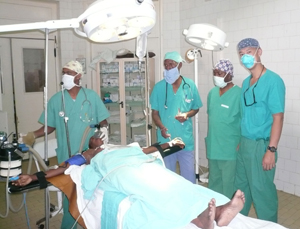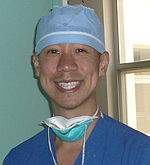May 23, 2011 - By Ruthann Richter

Tom Nguyen performs surgery with colleagues at a hospital in Asmara, Eritrea, as part of the Yale/Stanford Johnson & Johnson Scholars Program, which sends U.S. doctors abroad.
While working as a volunteer physician in Liberia, Stanford’s Brian Blackburn, MD, met far too many patients who died for lack of the most basic medical resources, like oxygen or transfusion services. He recalled one patient, a man in his 40s, whose kidneys failed after he contracted malaria and was to be evacuated to neighboring Ghana because there was no dialysis machine in Liberia. He died before the scheduled airlift.
“It opened my eyes to what much of the world has to deal with,” said Blackburn, a clinical assistant professor of medicine, of his experience with the Yale/Stanford Johnson & Johnson Scholars Program. “It changed my view of the world. At Stanford, we are really, really lucky. Liberia is at the other extreme, but there are many other countries like that. It makes me want to help people in places like Liberia. Without that help, people are going to die all the time.”
The Johnson & Johnson program celebrated its 30th anniversary in April with a daylong global health symposium at Yale University, where it was founded by Michele Barry, MD, and her colleague, Frank Bia, MD. Barry, now senior associate dean for global health and director of the Center for Global Health at Stanford, began the program in the post-Vietnam era, as she had become particularly interested in refugee health and care for patients from other cultures. She also believed residency training in the United States had developed a narrow focus and that U.S. doctors were starting to depend on new technologies, such as CT scans and MRIs, that were supplanting simple bedside techniques.
“We were losing touch with bedside training, and at that time I felt this program introduced the concept of humanitarian citizenship to medical training in the United States,” said Barry, a professor of medicine who brought the program to Stanford when she came in 2009. “I hoped to eventually build bilateral partnerships to inspire future academic medical leaders to work toward health equity and to help build medical capacity in resource-poor countries.”
The program, which Barry and Bia started with their own funds, began small, with just five or six residents at a single site in Haiti. Now some 70 residents and career physicians, including 15 to 20 from Stanford each year, volunteer at six sites, including medical facilities in Uganda, Eritrea, Borneo, Liberia, South Africa and, most recently, Rwanda. After the Haiti earthquake, Barry returned to her original site there to bring a $250,000 donation from Stanford to help with prosthetics and rehabilitation as well as hospital supplies.
Tom Nguyen, MD, former chief resident in surgery at Stanford, volunteered his time in Eritrea in an experience that was “life-changing and changed the way I approach medicine,” he said. His East African host country had five surgeons to serve a population of 3 million, so his services were in great demand.

Tom Nguyen
During his six-week stint, he performed about 90 operations, many of them lifesaving, on patients needing amputations, bowel repair or tumor removal, among other things. He performed the country’s first arteriovenous fistula, in which an artery and vein in the arm are sewn together to provide an easy access point for patients on dialysis. He had to rely on his good judgment in treating patients, as there was no pathology laboratory or any radiology services to confirm diagnoses.
For cancer patients, “You just go in, take the soft tissue mass out and call it a day,” he said. “Sometimes I’d try to find out what the tumor was. It was almost irrelevant because it wouldn’t change the management plan. They didn’t have chemotherapy or radiation therapy available. It was just an eye-opening experience.”
Often, he said, he’d operate without an anesthesiologist present, because there was only one available at his host hospital in Asmara, the country’s capital.
Now a cardiothoracic surgery fellow at New York-Presbyterian Hospital, he said he plans to continue to participate in international relief missions, “realizing that a little really goes a long way and the need is definitely there.”
To build capacity in resource-poor countries, the program involves training local physicians, which is what Blackburn did during his six-week stint in Liberia in 2010. The country was still recovering from a blistering civil war and had recently reopened its medical school and emergency room at the central hospital, the JFK Memorial Medical Center in the capital of Monrovia. Resources were extraordinarily scarce; the country had just 140 doctors to serve a population of 3 million.
On the general medical wards, Blackburn treated cases of pneumonia, tuberculosis, malaria, typhoid, kidney failure, stroke, parasitic infections and tetanus, a disease rarely seen in the United States. He watched patients die because no supplemental oxygen was available. A specialist in infectious disease, he didn’t have the benefit of a microbiology lab for testing, a CT scanner and other technologies routinely available in the United States. “It makes me appreciate the diagnostic and therapeutic capacity I have here,” he said. “I intend to continue working in the developing world. It is gratifying to teach and give back.”
Not just a clinical experience, the Johnson & Johnson program also has led to important research findings, Barry said. For instance, volunteers working with HIV patients in South Africa encountered the first problems with extremely drug-resistant tuberculosis, publishing their discovery in the Lancet.
“It shows that when you put people in the field, they can translate what they see into epidemiologic and basic science results,” Barry said. “What looks like a volunteer service rotation expands into a better understanding of basic science, as well as compassionate care.”
A program like this also can also affect a trainee’s career choice, she noted. A study she published with Yale colleagues in 1999 found that residents who served in international health programs were more likely to choose to become primary care physicians and to treat economically disadvantaged patients. They were also more likely to value the bedside exam and to have a positive view of health care in developing countries.
About Stanford Medicine
Stanford Medicine is an integrated academic health system comprising the Stanford School of Medicine and adult and pediatric health care delivery systems. Together, they harness the full potential of biomedicine through collaborative research, education and clinical care for patients. For more information, please visit med.stanford.edu.